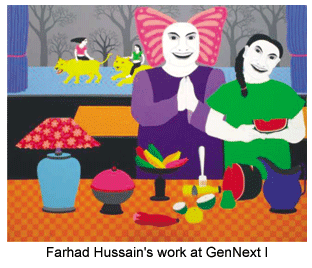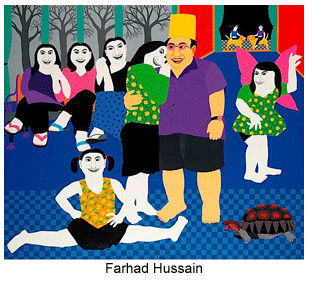- Prelude
- Hard Talk
- New Media
- Rolex : An Overview
- The age of Revivals: Neoclassical Furniture
- Democratization of the Medium No-Budget film: the Indian Context (!)
- Old Sound New Sound
- Decan Odyssey
- North East Opsis
- Russian cool breeze in hot Paris
- Around Kolkata
- Musings from Chennai
- In and around Santiniketan
- In between – from Vadodra
- A Tryst with Art in Madhya Pradesh
- Through the Looking Glass
- The Foreign Connection
- Market Insight
- Market Report
- Artist Index and Statistics
- Auction Reports
- The month that was
- Delhi Dias
- Art Bengaluru
- Mumbai Art Sighting
- Creative Impulse
- Subodh Gupta
- Pooja Iranna
- Preview
- In the News
ART news & views
Creative Impulse
Volume: 2 Issue No: 9 Month: 10 Year: 2010
Toeing the fine line between classy and crass, Farhad Hussain's artwork has the gravitational pull that leads one's eyes to it instantly even in a room full of paintings. With kitschy colors and play of human figures and animals, each painting and installation has a story to tell, not apparent at the first go. The smiles on the faces tend to grow on to look sinister, as if smiling at something beyond the viewer; the expressions heavy with secrets. The pink, yellows and blues that might look garish if used in such copious amounts anywhere else, look inviting when used by Farhad Hussain. They tend to approach the voyeur in the viewer, tempting formation of personal interpretations on and about the subject matter. As this exceptionally talented artist turned curator with his first show “Untitled-2010” at Art Konsult, Ravisha Mall traces his journey from Shantiniketan to Baroda to Delhi; from being a part of curated shows to being a curator himself, understanding it's reflection on his style and his growth as an artist.
 RM: One of your early major breaks was your show with Chatterjee & Lal.. How did it come about?
RM: One of your early major breaks was your show with Chatterjee & Lal.. How did it come about?
FH: I met Tara and Mortimer for the first time at my graduation show in Baroda. They came to see the display and i was exhibiting on the top floor of the department. The work clicked with them instantly. It was a big boost. Even a little appreciation did a whole lot of wonders. They specifically found the humour in the works very interesting and could see the emergence of my stylistic language. At the time not many people were open to experimenting with new artists and the association with Chatterjee & Lal proved to a stepping stone for me. Their confidence in me helped begin my journey as a recognised contemporary Indian artist.
RM: There was a perceptible difference in your paintings from those in your graduation show in Santiniketan and those in the show at Baroda... which place do you think had a larger impact in you as an artist?
FH: I studied at Kala Bhawana, Santiniketan from 1998 to 2003. Those years still remain, perhaps, the foundation of my artistic sensibilities. You can see the inspiration from Kalighat Patua paintings in the visual treatment of my earlier works. At the time I could sense that something was missing. I got good reviews but nothing set my work apart from those of my peers studying from the same institution. The traces of my work from then still carry on but now with a tinge of my own brand of eccentric humour. At MSU, Baroda my works took off onto a different tangent and the characters, especially the female ones, possess a certain shock value. The stories behind the works are now less apparent, more cryptic and still very in-your-face.
RM: Could you elaborate your artistic journey a little bit? Since your Santiniketan days you have has been settling into a rhythm…displaying a certain comfort with your stylistic traits…giving a hint towards a stylisation very early of your artistic journey. Is that a cause for concern?
FH: I feel that my current vocabulary is discernible only from my Baroda period. Yes, of course: adopting a fixed 'style' early in an artist's career is a blessing and a curse. But then, i think in my artistic career i have gone on to produced kinds of work that people never expected.
RM: What kind of viewers do you think your style of art caters to specifically?
FH: My paintings from 2000 to 2003 use Calcutta-culled image-making for unexpected purposes: bloated, pink forms contort themselves into lewd and ludicrous poses. Drawing inspiration from the sexual acrobatics of Jogen Chowdhury's figures, my portrayals of mating rituals are many shades more bizarre: in one a massive, pink woman with breasts that might look like evil little daggers may seem to be yelling profanities at viewers. 
Lately I have toned up the palate to include lots of pink and yellow and electric blue, and I feel that increasingly my characters have become more recognisable. The scenes, the figures, the roles they play in the composition are all borrowed from real life. The houses, their windows, the people living within seem to have dark overtones due to the familiarity the viewer feels when looking at the work.
RM: Can you give us an insight in to how viewers, collectors and critics have responded to?
FH: The treatment of the medium, the color palette and the element of animation in the visual quality of the works has attracted rave responses from children of all ages. They have generated a similar interest in those upto the curators of international biennials and major international collectors.
RM: As you gained recognition, did your new-found financial confidence and artistic space help you express yourself more freely?
FH: I think the confidence probably made me less intimidated to express in my work the eroticism that was somewhat downplayed. In addition I have begun to increasingly work on very large format canvases. That was really liberating, as I feel that I am really comfortable with large format, and there is a certain ease in handling.
RM: You recently curated a show with a group of young contemporaries, “Untitled-2010”. Did your experience and sensibilities as an artist have an impact on your planning of the show?
FH: As an artist who has been a part of many curated group shows with long monotonous concept notes and the increasing sense of being bound by the while producing the work, I can understand the precarious position an emerging artist sometimes finds her/himself in. with “untitled-2010” I made an attempt, as many other curators are doing nowadays, to give a group of promising artists an open platform to unleash their creativity in whatever manner they chose to do so. Moreover, there have been certain discomforts about other curated shows which I wanted to address as an artist. The concept behind this show wasn't theoretical or philosophical. It was purely an artist-centric show.